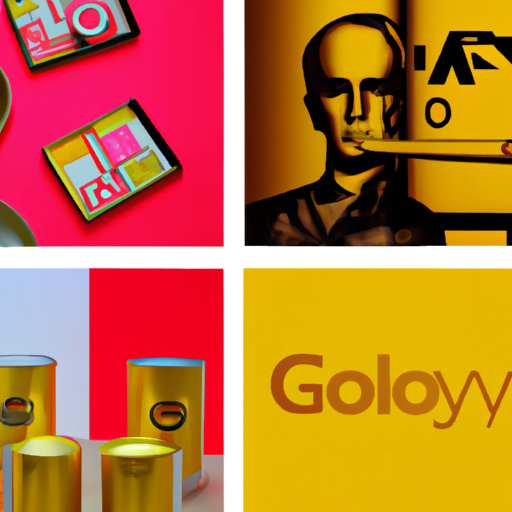
-
Table of Contents
- Designing Artistic Merchandise for Brands and Events
- The Importance of Artistic Merchandise
- Key Elements to Consider in Designing Artistic Merchandise
- 1. Brand Identity
- 2. Target Audience
- 3. Unique and Eye-Catching Designs
- 4. Quality and Durability
- 5. Versatility
- Case Studies: Successful Artistic Merchandise Designs
- 1. Red Bull
- 2. Coachella Music Festival
- Designing Tips for Compelling Artistic Merchandise
- 1. Keep it Simple
- 2. Experiment with Colors
- 3. Collaborate with Artists
- 4. Incorporate Storytelling
- Summary
Designing Artistic Merchandise for Brands and Events

Artistic merchandise has become an integral part of brand promotion and event marketing. From t-shirts and posters to phone cases and tote bags, artistic merchandise allows brands and events to connect with their audience on a deeper level. In this article, we will explore the importance of designing artistic merchandise, the key elements to consider, and provide valuable insights into creating compelling designs that resonate with consumers.
The Importance of Artistic Merchandise
Artistic merchandise serves as a powerful tool for brand recognition and event promotion. It allows brands and events to extend their reach beyond traditional marketing channels and create a tangible connection with their audience. Here are some key reasons why designing artistic merchandise is crucial:
- Brand Awareness: Artistic merchandise featuring a brand’s logo or unique design elements helps increase brand visibility and recognition. When consumers wear or use these items, they become walking advertisements, spreading awareness wherever they go.
- Memorability: Well-designed artistic merchandise creates a lasting impression on consumers. It serves as a reminder of their positive experience with a brand or event, increasing the likelihood of repeat engagement.
- Revenue Generation: Artistic merchandise can be a significant source of revenue for brands and events. By offering unique and desirable products, they can tap into the market of loyal fans and supporters who are willing to purchase these items.
- Community Building: Artistic merchandise fosters a sense of belonging and community among consumers. When individuals wear or display merchandise from a brand or event, they become part of a larger community, creating a sense of camaraderie and shared identity.
Key Elements to Consider in Designing Artistic Merchandise
Designing artistic merchandise requires careful consideration of various elements to ensure the final product is visually appealing, on-brand, and resonates with the target audience. Here are some key elements to consider:
1. Brand Identity
Artistic merchandise should align with the brand’s identity and values. It should reflect the brand’s personality, aesthetics, and overall message. For example, a brand known for its minimalistic and clean design approach should incorporate these elements into their merchandise designs.
2. Target Audience
Understanding the target audience is crucial in designing artistic merchandise that resonates with consumers. Conducting market research and analyzing consumer preferences can provide valuable insights into the design elements, colors, and styles that will appeal to the target audience.
3. Unique and Eye-Catching Designs
Artistic merchandise should stand out and grab attention. Unique and eye-catching designs are more likely to attract consumers and make a lasting impression. Incorporating bold colors, intricate illustrations, or clever typography can help create visually appealing designs.
4. Quality and Durability
Ensuring the quality and durability of artistic merchandise is essential. Consumers expect merchandise to be made from high-quality materials that can withstand regular use. Using reputable suppliers and conducting quality checks can help maintain the brand’s reputation and customer satisfaction.
5. Versatility
Designing merchandise that can be used in various settings and occasions increases its appeal and usability. For example, a t-shirt design that can be worn casually or dressed up for a special event provides versatility to the consumer, making it more likely to be purchased and used frequently.
Case Studies: Successful Artistic Merchandise Designs
Let’s explore some case studies of brands and events that have successfully designed artistic merchandise:
1. Red Bull
Red Bull, known for its high-energy brand image, has created a range of artistic merchandise that reflects its adventurous and extreme sports-oriented identity. Their merchandise includes bold and dynamic designs featuring their iconic logo, vibrant colors, and action-packed imagery. By aligning their merchandise with their brand identity, Red Bull has successfully created a strong connection with their target audience.
2. Coachella Music Festival
Coachella, one of the most popular music festivals globally, has become synonymous with artistic merchandise. Each year, they collaborate with renowned artists and designers to create limited-edition merchandise that captures the essence of the festival. These designs often incorporate vibrant colors, psychedelic patterns, and references to the festival’s iconic art installations. The limited availability of these designs creates a sense of exclusivity and drives demand among festival-goers.
Designing Tips for Compelling Artistic Merchandise
Here are some design tips to create compelling artistic merchandise:
1. Keep it Simple
Simplicity is key when it comes to designing artistic merchandise. Avoid cluttered designs and focus on creating a clear and impactful visual message. Minimalistic designs often have a timeless appeal and can be more versatile across different merchandise items.
2. Experiment with Colors
Colors play a crucial role in design and can evoke specific emotions or associations. Experiment with different color palettes to create the desired mood or align with the brand’s identity. Consider the psychological impact of colors and their cultural connotations to ensure the design resonates with the target audience.
3. Collaborate with Artists
Collaborating with artists and designers can bring fresh perspectives and unique artistic styles to the merchandise. This collaboration can help create limited-edition or exclusive designs that attract collectors and fans of both the brand and the artist.
4. Incorporate Storytelling
Artistic merchandise can tell a story and create a deeper connection with consumers. Incorporate elements that reflect the brand’s history, values, or the event’s theme. This storytelling aspect adds an extra layer of meaning to the merchandise, making it more meaningful and desirable to consumers.
Summary
Designing artistic merchandise for brands and events is a powerful marketing tool that enhances brand recognition, generates revenue, and fosters a sense of community. By considering key elements such as brand identity, target audience, unique designs, quality, and versatility, brands and events can create compelling merchandise that resonates with consumers. Case studies of successful brands like Red Bull and Coachella demonstrate the effectiveness of well-designed artistic merchandise. By following design tips such as simplicity, color experimentation, artist collaborations, and storytelling, brands and events can create memorable and impactful merchandise that leaves a lasting impression on their audience.
